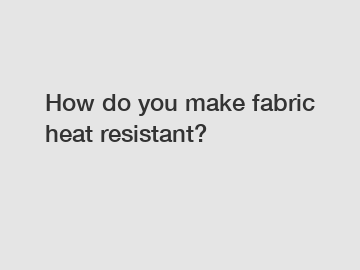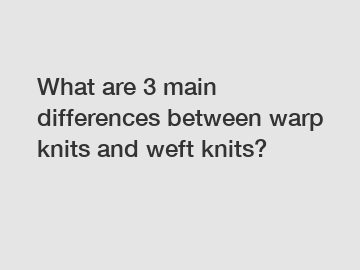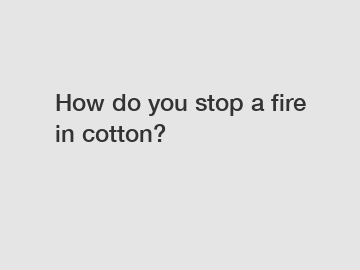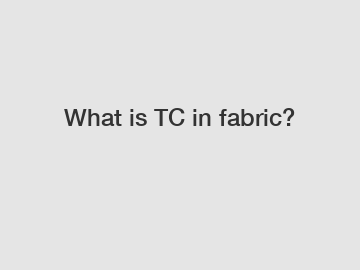How do you make fabric heat resistant?
How Do You Make Fabric Heat Resistant?
In various industries, there is a growing need for heat-resistant fabrics. Whether it's for protective clothing, thermal insulation, or even household applications, having fabrics that can withstand high temperatures is crucial. But how exactly is fabric made heat resistant? In this article, we will explore the different methods used to achieve heat resistance and discuss the importance of using such fabrics in certain applications.
Understanding Heat Resistance.

Heat resistance refers to a fabric's ability to withstand high temperatures without undergoing significant damage or structural changes. In its natural form, most fabrics are not heat resistant. However, through various treatments and modifications, fabrics can be transformed into heat-resistant materials. This is an important quality to have, especially in industries where workers may be exposed to extreme temperatures or where materials need to withstand heat-intensive processes.
Weaving Techniques and Material Selection.
One of the primary methods for making fabric heat resistant is through the selection of appropriate materials and weaving techniques. Synthetic fibers such as aramids, carbon fibers, and fiberglass are known for their high heat resistance. By utilizing these fibers, manufacturers can create fabrics that are inherently heat resistant. Additionally, specific weaving techniques, such as tight weaves or specialized patterns, can enhance the fabric's ability to resist heat.
Coating and Lamination.
Another popular method for creating heat-resistant fabrics is through coating and lamination processes. In these processes, a layer of heat-resistant material is applied to the fabric's surface, forming a protective barrier. The coating can be made from various heat-resistant substances such as silicone, polyurethane, or ceramic. This barrier prevents heat from penetrating the fabric and offers additional thermal insulation properties. Lamination involves bonding multiple layers of fabric together, with at least one layer being heat resistant. This method enhances the fabric's durability and heat resilience.
Chemical Treatments and Flame Retardants.
Explore more:Is 60% cotton and 40% polyester good?
Weft-knit Wonder: Which Celebrities Rock this Trendsetting Style?
When was fleece fabric invented?
Enhancing Your Chess Experience with Microfiber Towels
Where is polyester most commonly found?
Reviving Vintage Fashion: How Can Fabric Fr Bring Back Classic Styles?
Discover How to Choose Flame Resistant Fabrics with Ease!
Chemical treatments can also make fabrics heat resistant. Flame retardants are commonly used in industries where fire hazards exist. These chemicals are either applied directly to the fabric or included in the dyeing process. Flame retardants work by delaying or inhibiting the spread of flames, thus making the fabric more heat resistant. While flame retardants are effective in preventing fires, it's essential to ensure their proper usage and adherence to industry safety regulations.
Importance of Heat-Resistant Fabrics.
Heat-resistant fabrics have numerous practical applications. In protective clothing, such as firefighting suits or industrial workwear, heat resistance is critical for shielding workers from thermal hazards. In the automotive industry, heat-resistant fabrics are used in engine compartments to protect against high temperatures and fire risks. These fabrics also find applicability in aerospace, where aircraft components and cabin interiors must withstand extreme heat conditions. Moreover, heat-resistant fabrics have household uses like oven mitts and ironing board covers, ensuring safety during everyday activities.
Closing Thoughts.
In conclusion, creating heat-resistant fabrics involves a combination of material selection, weaving techniques, coating and lamination, and chemical treatments. Each method has its advantages and suitability for different applications. Heat-resistant fabrics play a vital role in various industries where exposure to extreme temperatures or fire hazards is common. These fabrics provide protection, enhance safety, and ensure optimal performance in a range of demanding environments.
If you are interested in heat-resistant fabrics or have any inquiries, please feel free to contact us. Our team of experts will be happy to assist you and provide further information about our products and services.
Contact Us:
Email: info@heatresistantfabrics.com.
Phone: XXX-XXX-XXXX.
For more flame proof fabric, flame retardant cloth, neon yellow fleeceinformation, please contact us. We will provide professional answers.
Explore more:Is microfiber fabric expensive?
What are the different types of grey fabric?
Mastering Industrial Cleanliness: Unveiling the Best Dust Mops
Discover the Safest Natural Flame Retardant Fabric: Your Ultimate Guide!
When should you throw out microfiber towels?
Printed Pocketing Fabric: Enhancing Style & Utility with Versatile Designs!
Are microfiber mops worth it?










